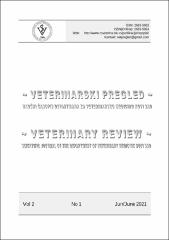In vitro ovicidal activity of mixture of linalool and estragole against gastrointestinal nematodes of sheep

View/
Date
2021Author
Štrbac, Filip
Bosco, Antonio
Amadesi, Alessandra
Rinaldi, Laura
Mangieri, Giuseppe
Stojanović, Dragica
Simin, Nataša
Orčić, Dejan
Pušić, Ivan
Krnjajić, Slobodan
Ratajac, Radomir
Metadata
Show full item recordAbstract
Based on the results in different studies conducted so far, plant essential oils (EOs) are
recently been marked as a possible solution for the problem of anthelmintic resistance (AR).
However, their efficacy against a wide range of livestock parasites is due to active ingredients.
In that context, the aim of this study was to evaluate the in vitro ovicidal effect of a mixture of
linalool and estragole (14% : 86%, respectively) against sheep gastrointestinal nematodes
(GINs) using the egg hatch test (EHT). The study was conducted using faecal samples of
naturally infected sheep by GINs from two different farms located in Southern Italy.
Coproculture of tested faecal samples was performed, as well as chemical analyses of the tested
mixture. The egg hatch test (EHT) was performed at six different concentrations (50, 12.5,
3.125, 0.781, 0.195 and 0.049 mg/mL) and the obtained values were compared to the positive
control (thiabendazole, 0.025 mg/mL) and the negative control (3% Tween 80, v/v). The tested
binary combination showed high and dose-dependent ovicidal activity varied from 29.5% to
100%. The inhibitory effect on egg hatchability was similar (p>0.05) to the positive control
(98.0%) at concentrations of 50 mg/mL (100%), 12.5 mg/mL (100%) and 3.125 (99.8%).
Moreover, all tested concentrations showed significantly higher (p<0.001) activity compared to
the negative control. The obtained results suggest that the combination of linalool:estragole has
the potential to be used against sheep GINs. These also highlight the possible role of different
combinations of certain constituents of essential oils in combating AR. However, these findings
need confirmation in further in vivo studies.
